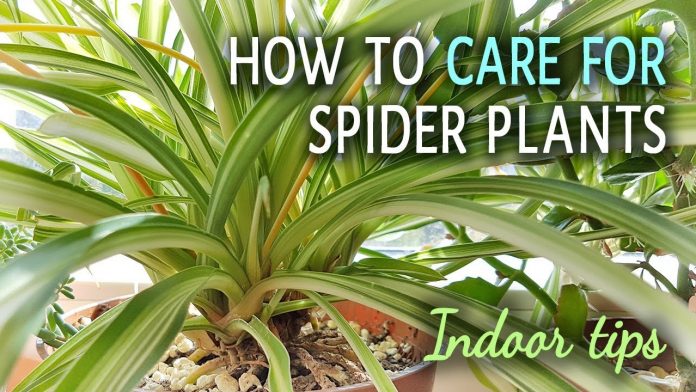At present as an indoor houseplant spider plant has gained much popularity. By providing a suitable environment, they like to grow properly and gives a stunning look to the whole environment.
As there is mainly green variety available but some other varieties also include as a green and white striped plant. And in this article, we have covered the spider plant care process and how to grow spider plants properly.
Table of Contents
What is a spider plant?
The scientific name of the spider plant is chlorpophyutm comosum. It is also called airplane plants, ribbon plants, or spider ivy. This plant grows by forming clusters of glass-like leaves. This plant is also considered as one of the most adaptable indoor or outdoor plants that give a bushy look.
It is originated from southern Africa and easy to grow as a houseplant. Mature plants have small flowers that are produced as a cluster and form tight ornaments of arching leaves with an abundance of hanging plantlets on a long stem. It has fleshy and tuberous roots and
How to grow spider plant:
Propagation: Spider plants are considered as the coolest indoor plant to propagate. For propagation spider large plants, you have to separate the large spider plant from small plants. You can do it by towing or cutting the root ball into numerous fragments. Keep in mind each cutting should have some leaves and repot has to do with fresh potting medium.
Again you can pluck off plantlets and root them in a cup of water. But the propagation is done including rooting spider plant babies, propagation by division, or growing them from seed. But for that, it’s important to know what spider plant babies are. In general, spider plant babies are known as spiderettes or plantlets.
From the main plant, plantlets are grown out. During summer, they bloom flower and by pollination, plantlets produce seeds. After maturation, these spider plantlets can be grown as new plants. Propagation can be done by following ways-
- Propagation by roots
- Transplanting
- Propagation by Dividing process
Propagation through rooting spider plant babies: The most common procedure of propagation through rooting is the developing spider plant life from toddlers. Several techniques are blanketed to grow spider toddlers. It may be finished from cuttings, or by rooting in water or a propagation chamber.
Propagation from cuttings:
Spider vegetation propagation via cuttings takes a few days to a couple of weeks depending on the technique of propagation. When toddlers begin to develop through root formation then the cuttings have to take. At this time, you should put off it from the mother plant by reducing it properly.
Sometimes baby spiders come out easily from the mother plant. If it occurs then it is not required to reduce them from the main plant. It is better to cut them from the close to the spider plantlets by using sterile scissors to get a proper cutting. After cutting the baby plantlets from the mother plant, trim the long stem to the nethermost of the subsequent one.
Rooting spider plant babies in water:
It is the most effective manner to propagate spider plants by setting the babies in water for new root formation. There is one disadvantage. By developing the cuttings in water the baby spider flowers can be rotted. Another problem is that after transplanting it into the soil, the baby spider also can go returned to shock.
In this time when toddlers may be rooted in water, it will become weak than earlier than. And it takes a long time to get better after being planted in soil. For setting plantlets in water, at first reduce the developing leaves at the base of the plantlet. If any plant life is present and flooded underwater then it’ll rot. Use a deep or clear vase to peer the bottom of the root. Now fill the vase with sufficient water so that it best covers the toddler plant.
Propagation of connected spider plant babies:
If spider plant toddlers are still attached to the mom plant then you definitely ought not to worry approximately uproot shock. In this manner, the developing plant can be much stronger from the initial stage. But the factor is that this manner is a little bit hard because of attaching to the mom.
Due to this reason, they won’t root as eagerly as they do normally. In this system, you can use an ordinary potting mix via putting a pot of soil after the mom plant. Now twig the target roots of the baby spider plant into the soil. It’s encouraged to put the rooting hormone to enhance and accelerate the root bloom.
Rooting spider in a propagation chamber:
A propagation chamber is used for spider flowers to maintain the humidity level. Proper humidity facilitates the spider root to develop faster. By presenting backside heat, growing a mini-greenhouse by overlaying the plantlets and soil with a plastic bag, rooting toddler spider plants is achieved.
But a proper potting soil is needed for propagation chamber. A proper blend of vermiculite, peat moss also known as coco coir and perlite or pumice is critical for the propagation chamber. For developing baby sprout faster, dip the roots in rooting hormones.
Transplanting:
Transplanting has to do to develop several new roots earlier than potting spider plant infants. Now use a well-known potting soil to position them up. After planting the rooted toddler into its pot, water it properly, cast off the excess water using the drainage system, and hold the soil moist. Propagation for slicing roots takes a longer time to get a better result after being transplanted into soil. A stable position of the plant will display new growth. Then a right spider plant care has to take.
Dividing system:
The dividing manner is another way to propagate the spider plant. At least there two clusters developing within the pot you may cut up them apart. But dividing of spider can be hard if there is a mature and pot-sure plant. And if the roots are thick and tightly packed then you need to use a sterile knife to cut them otherwise, virtually tear the roots apart till the clumps are separated.
How to take care of the spider plant:
For spider plant care, some facts have to maintain. Spider plants grow under those environments where some things have to consider. Spider plant care in summer and during other seasons is also different. Again spider plant care outdoors and indoors is also not so common. Considering all these, the caring procedure of spider plants are discussed below-
Soil: As spider plants are very adaptable so you don’t have to worry. But, a proper potting mix is required to grow a spider plant. If you want to grow spider plant outdoors then choose good drainage soil. The sand containing soil is better regarding this matter. And if you want to grow your spider plant as indoor in a pot then select a potting mix that contains vermiculite or coco coir.
Light: Proper spider plant care light is an important fact. You have to know spider plants don’t need a lot amount of light for proper spider plant care. Due to its low light feature, many people like to grow it in bathrooms and bedrooms. Some like to grow in windowsills where an indirect or filtered light is provided. Outdoor plants require shade during day time.
But if spider plants are kept under extreme sun exposure then leaves and steams are faded or blenched. So, if you want to grow spider plants outside then provide a shadier location or place or put it near a tall plant that will provide shade. It will help to get in direct sunlight. Considering this, a suitable location is another important fact for spider plant care.
Temperature and humidity:
Spider plants prefer to grow in the temperature of 50° F (10° C) to 80° F (27° C). For proper spider plant care humidity, the place with freezing temperatures is not suitable for a spider plant. This plant flourishes properly in humid conditions.
Watering: Watering has to do properly for spider plant care. Distilled water or purified water is required for a spider plant. But some other things have to keep in mind while watering spider plants. These are as follows-
- Spider plants are sensitive to fluoride and other minerals that tap water contains. So don’t use tap water for spider plant care. It can destroy the spider plant.
- Water used for spider plant has to keep in room temperature because of cold and hot water shock the spider plants and make them weak.
- To check the soil condition for watering, put your fingertips to the soil. If the top of the soil is dry then you have to water them again.
- Water in a moderate way once or per week during the first year for taking proper spider plant care.
- Keep the soil consistently moist but not overly wet for spider care.
- To remove excess water, use a drainage pot.
Fertilizer: Spider plants require a little amount of fertilizer during the growing season. In general, fertilizer is provided to spider plants 1-2 times per month during the spring and summer season. It’s better to apply liquid fertilizer that gives a good result than granular fertilizer. While applying fertilizer, follow the instructions properly to know the proper amount of fertilizer that has to apply at the base of the plant.
Repotting: Repotting is done when your baby spider plants are growing properly and roots began to grow through the drainage holes. By this time you need to transfer your spider plant into a larger container. This should be done in the spring. But before repotting, a fresh potting medium and container are required. Chose a container that has a good drainage system. This will prevent the plant from waterlogged.
Trimming: Trimming has to do to remove the brown or dead leaves or leaf tips. Cut the tip or leaf top by using scissors so that plants can grow properly. Proper trimming is done to use plant energy that directs the plants towards healthy leaves.
Pest control: Commonly, most of the plants are affected by pests. The most common nuisance of the spider plant is spider lice. It causes dull, greyish leaves and curly substances on the side portion of the leaves. For that, it’s better to use natural insecticide. Such as neem oil is beneficial regarding this matter.
Tips:
- While growing in shelves, place them away from 12 inches away from south-facing windows during the spring and summer months for spider plant care.
- It’s better to place a humidifier for spider plant care in the place where you want to grow spider plants as an indoor houseplant.
- You can use a plant mister to mist it daily or can keep the pant in a humid room.
- Use a tall skinny for rooting spider plant babies in water.
- A fast-draining well-aerated potting mix is suitable for a spider plant.
- Watering has to do in such a way so that excess water can’t remain in the pot.
- Don’t put outdoor spider plants in direct sunlight that may burn the spider plant.
- Avoid applying fertilizer during the winter season or they are expanding their structures in their pots.
- While propagating baby spider plants, place a cotton ball or a thin layer of a napkin in the cup of water. It will help to keep the root from being absorbed.
FAQ:
- How much sunlight is required for the spider plant?
Bright filtered sun or partial sun is required for spider plant care.
- How to take spider plant care as a houseplant?
By providing the right amount of light, potting mix, temperature, water, fertilizer, and controlling pest, you will be able to take the spider plant care.
- How long spider plants live?
Spider plants tend to live for a long time. Considering their favorable condition, they like to live two to ten years.
- How often have to water a spider plant?
You have to notice that if the top 1 inch of soil remains dry then watering has to do. Water in a moderate way or once per week for 1 year and then water periodically.








